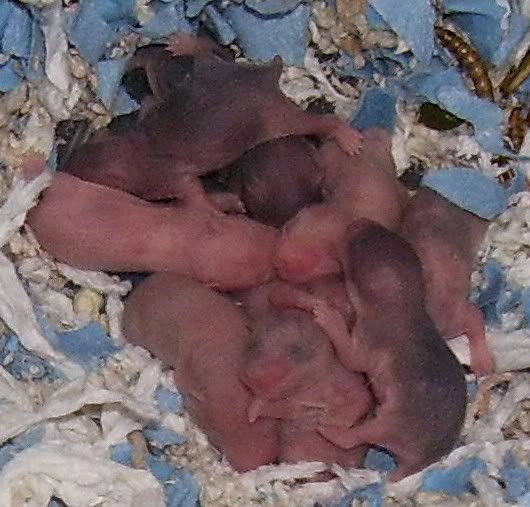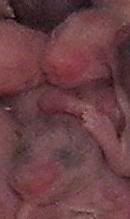|
|
|
|
Gerbils are generally left together in bonded breeding pairs or groups for life and nature takes it's course.
First let me say that breeding is a big responsibility. One pair could easily produce 100 pups in their lifetime, if not more. You need to make sure your area has a good market for pocket pets so that you can find homes for all of them BEFORE making the decision to breed. If you think there is money to be made in breeding you're wrong. The cost of housing, food and bedding is much more then what any pet store will give you for pups, if they give you anything. Private sales are few and far between. Even if you could sell all of your pups from all of your litters via private sales it would not meet the costs of raising a litter.
![]() Please read To Breed or Not to Breed first, then visit the Rescue pages before
deciding to breed.
Please read To Breed or Not to Breed first, then visit the Rescue pages before
deciding to breed.![]()
Unfortunately for you, your pet may be a mother soon and you didn't know it. Most pet stores keep the litter together - boys and girls - as long as they can to save space. Girls can get pregnant as young as 3-4 weeks and boys can impregnate as young as 4-5 weeks. This usually requires an experienced partner but not always. It's the rare pet store that has staff able to properly sex animals so the two 'boys' or 'girls' may actually be a boy and a girl. Even if you do get two girls they may both be pregnant from their cage mates.
There are certain animals that should not be bred. Check out the Health Issues on the 101 page for things to look out for.
It's best to have the breeders in a bonded pair set up. Some become more attached to their mates then others. They are Matriarchal and the girls rule. Some breeders have had success with multiple males with a single female. Very few have had luck with multiple females with a single male. Multiple females usually results in fights between the moms over males, territory and babies with injuries and death resulting.
Gerbils become sexually mature at 8-12 weeks of age. Females come into heat every 4 days for 24 hours. The male will start to thump when the female goes into heat (not like the alarm thump which will make every other Gerbil in hearing range stop and listen). When Gerbils breed it's almost like tag and chase. The male will sit in a corner and thump, then rush to the female and breed. They'll break apart and go to separate corners and clean themselves. They will repeat this for hours, taking small naps in between.
The gestation (length of pregnancy) for a Gerbil female's first litter it's around 21-25 days, most give birth on the night of the 24th day. Consecutive Gerbil litters have a longer gestation period of 35-45 days. As the pregnancy progresses, the female will develop a "pear" shape to her body. If you can see pups moving in the female's stomach the birth is only days away. You should do a last major cage cleaning a couple of days before you expect the litter. This will give the expectant mother a chance to build a suitable nest and feel secure in her home. Besides her normal bedding material, give her plenty of cheap, white, unscented toilet paper to line her nest. Make sure the expectant mom has plenty of water available. Do not restrict food intake at this time. Supplement her food with fresh, raw vegetables, cooked chicken and cooked egg (no frying, spices or seasonings). This is also a good time to pull out any weaned pups that may still be with the folks.
Rodent females will go into heat the day or evening they give birth. This is called post partum estrus. She will settle the pups in the nest and then she'll breed if a male is present. Do not interfere.
With Gerbils, you can expect anything from 1-9 pups in a litter, 5-6 being the average. Delivery will normally take place during the night. She may give birth around the tank and leave the pups there as she delivers the next one. Don't panic. Mom will gather them up afterwards into the nest. Do not interfere.
The male (in a bonded mate situation) will help the female with the babies, keeping them warm while the mom takes a break, cleaning them, etc. In a colony situation or all girl group an Aunt will help. Only separate them if there are problems or if you don't want another litter. For temporary birth control you can split cage the parents while the litter is being raised, thus removing the need to reintroduce the pair. I recommend you use ¼" hardware cloth so the parents can't pass babies from side to side. Roborovski weanlings can easily pass through ½" hardware cloth.
With a new mom, new mate situation, or stress; the mom or another adult may attack the pups. Gerbils are matriarchal and don't often tolerate multiple females within a mating group. If it's a new partnership the female may not trust the male and destroy her litter rather then let him hurt them. New ownership is also stressful to all species.
Having given these dire warnings most litters manage just fine especially without human intervention. The best thing you can do is leave mom and dad to do what nature tells them. Most animals know instinctively how to care for their babies. The worst thing new breeders can do is interfere with the litter too soon. The parents will not sit constantly on the nest. They will take breaks to take care of bodily functions - including mating. Most homes are kept at a temperature that the pups do not need constant warming from a parent. And if otherwise healthy they don't need to constantly nurse. Sometimes nursing pups don't let go when mom leaves her nest. Again, let mom take care of things. She'll hear them and gather them back up into the nest. The safest action is to not get involved too quickly with a litter. Some pups may not survive because they were too small or something else is wrong. Mom will usually clean up the nest area by eating any dead pups. This may sound disgusting but it actually helps give the mom some nutrition back that she looses while having a litter. Keeping dead animals out of the nest is a survival instinct to keep predators away, too.
Newborn pups are generally called pinkies. They are born naked, deaf and blind. At this stage they react to heat and touch. They roll onto their backs while mom huddles over them to nurse. Later as they get bigger and grow fur, mom will lay on her side or back to nurse. You can tell from birth what color their eyes will be by looking at their eyelids. If the eyelids are pink then their eyes will be red, if the eyelids are dark then they'll have black eyes. You can even see some pigment and patterning at birth. The pictures below are of a Syrian litter that's two days old. This is typical of what you can see in any rodent litter. You can already see skin pigment and the close-up on the right shows a black eyed pup (bottom) and a red eyed pup (top 2).
 |
 |
 You
should continue to supplement mom's food and you may add KMR® (Kitten
Milk Replacement). Use a shallow dish that pups can easily climb out to avoid drowning. This is a good transition food for weanlings and mom
can use the extra while nursing.
You
should continue to supplement mom's food and you may add KMR® (Kitten
Milk Replacement). Use a shallow dish that pups can easily climb out to avoid drowning. This is a good transition food for weanlings and mom
can use the extra while nursing.
Moms may be very protective of their babies and territory (the tank or cage). It's best to leave everybody alone until the pups are roaming on their own AND mom stops trying to herd them back into the nest, usually 14 days. You can sometimes entice the mom out of her nest with a healthy bit of food and peak into the nest. Always wash your hands then rub some of the bedding in your hands before handling pups. Any strange smell on them could upset the parents. Cup your hands over them and hold them near the ground or the bottom of the tank so that if they jump they don't have too far to fall.
At 3 - 4 weeks the pups should be weaned from the mom. At 6 weeks the pups need to be separated by sex into their own tanks until you can rehome them.

| 2009 Mid Atlantic Show |
  |
 |
|
| ||||||||||||||||||||||||||||||||||||||||